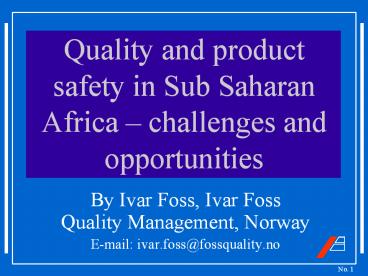Quality%20and%20product%20safety%20in%20Sub%20Saharan%20Africa%20 - PowerPoint PPT Presentation
Title:
Quality%20and%20product%20safety%20in%20Sub%20Saharan%20Africa%20
Description:
Quality and product safety in Sub Saharan Africa challenges and opportunities By Ivar Foss, Ivar Foss Quality Management, Norway E-mail: ivar.foss_at_fossquality.no – PowerPoint PPT presentation
Number of Views:126
Avg rating:3.0/5.0
Title: Quality%20and%20product%20safety%20in%20Sub%20Saharan%20Africa%20
1
Quality and product safety in Sub Saharan Africa
challenges and opportunities
- By Ivar Foss, Ivar Foss Quality Management,
Norway - E-mail ivar.foss_at_fossquality.no
2
My background
- 13 years in Det norske Veritas, 5 years as
Executive Vice President - Ivar Foss Quality Management established in 1987
- 11 years of consulting in CEEC
- Last 3 years Consulting on trade development in
Africa. Clients Sida, Norad, UNIDO, ISO etc. - Lived in Kenya for two years
3
The Sida/Norad strategy project
- The main report is available from Sida, see
www.sida.se
4
African trade initiatives
- African Union
- The African Common Market
- NEPAD Market Access Initiative (2001)
- Points out the need to increase value added in
agro-processing and mineral beneficiation - Promotes development of the private sector
- Give specific recommendations for removal of
Technical Barriers to Trade (TBT) - Sets objectives for agriculture, including food
security, but is not specific with regard to
Sanitary and phytosanitary Measures (SPS)
5
Trade areas
CapeVerde
Sey-chelles
Como-ros
Mauri-tius
6
Vegetable export from Kenya
- HCDA packing and storage facility at Nairobi
Airport
7
Testing laboratories
- Kenya Bureau of Standards, Nairobi
8
New solutions in metrology
- Mobile calibration laboratory for Mozambique
9
Objectives in three dimensions
- Each country has to protect its own society
against hazardous and sub-standard products,
imported as well as domestically produced - Exporters have to comply with the increas-ingly
demanding requirements in target markets - Complying to requirements is not enough the
products must also be attractive in the target
markets. Supply side development is required
10
General and Targeted Strategies
Awareness building Engagement and basic training
11
Creating awareness -why is it so important?
- No change will take place until influential
stakeholders are convinced of the need for change!
12
Two sets of strategies
- Defensive strategies
- Regulate only when risks are significant
- Limit national legisla-tion make use of
international standards - Simplify conformity assessment procedures
- Develop the quality infrastructure
- Improve transparency
- Offensive strategies
- Collect info. on Technical Regulations, standards
and conformtiy assessment in target markets - Map market requirements
- Develop a tailormade conformity assessment
infrastructure - Develop quality as a competitive strategy
13
Ensure safe products on domestic markets
- Laws and regulations
- Standards
- - Market surveillance
Imports
Trade andindustrypolicy
14
The food chain approach for the SPS area
Planthealth
Animalhealth
Foodsafety
Multidisciplinary approach
Codex
OIE
IPPC
- Scientific risk assessment
- HACCP
15
The SPS infrastructure
- Most African countries have not adopted the food
chain approach. Present legislation is outdated - National SPS policies are absent
- Responsibilities and resouces are scatted on many
ministries (up to 6) - The infrastructure for testing and enforcement is
weak - The risk analysis process is introduced only in
special cases, typically for export - Most countries are members of Codex, OIE and
IPPC
16
Standardisation in Africa
- 14 full members and 16 associates or
corre-sponding members of ISO - 50 countries are members of Codex and OIE
- 66 of NSBs are autonomous government bodies
- The NSBs have published few standards (lt 150)
- The distinction between standards and regulations
is blurred - Participation in international standards
development is low
17
The leapfrog strategy
Old problems and solutions
18
Traditional and new approach to standards
19
The international model for regulatory
harmonisation
Commonregulatoryobjectives
20
Harmonisation of standards
21
Recommended strategy for African standardisation
- Introduce the Reference to Standards Principle
and The International Model in legislation in
order to promote regional harmonisation - Accept international standards for industrial
products - Influence Codex, OIE and IPPC to take African
concerns into accounts - Establish regional African scientific committees
to support participation in international
standardisation - Develop African regional standards for products
and conditions that are specific to Africa
22
Regional development of con-formity assessment
services
- Calibration services (industrial and legal
metrology, proficiency testing) - Reference laboratories (chemistry and
microbiology for food safety, animal and plant
health) - Management system certification Quality,
environment, HACCP - Accreditation
- Scientifically based risk assessment
23
Present products and markets
Traditional Local, DomesticRegional Africa Emerging Middle EastIndia, etc. Demanding Europe, USA, Japan
Commodities Agricultutal products
Value-added prod.Processed agricult. prod.Textiles, leather, etc. A few success stories based on Just-in-time strategies
MineralsMetals, gems, oil/gas
24
Targeted Export Strategies
Traditional Local, DomesticRegional Africa Emerging Middle EastIndia, etc. Demanding Europe, USA, Japan
Commodities Agricultural products
Value-added prod.Processed agricult. prod.Textiles, leather, etc.
MineralsMetals, gems, oil/gas, etc.
25
The Just-in-Time Export Strategy
Supplier.Produceand sell
26
Quality as a competitive strategy
Developmentstage
1920
1960
2000
27
The important role of the NSB
- Standardisation
- Industrial as well as food safety, animal and
plant health - Arm length distance, independence from government
- Establish a good committee structure
- Other services
- Information centre, incl. WTO enquiry point
- Laboratory testing
- Certification services
- Calibration services, possibly metrology
institute - Training
- A national focal point for quality and product
safety
28
Conclusions
- Africa faces very large and multi-facetted
challenges in the areas of quality and product
safety - National policies should guide development
priorities - Targeted and specific strategies are required in
order to succeed - Regional cooperation is important for rapid
development - Export development must be accompanied by the
relevant conformity assessment structure - Both national and regional developments require
technical assistence
29
How do you eat an elephant?































